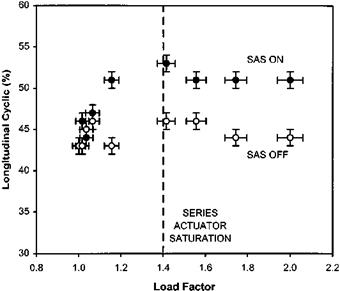Lateral and directional static stability
As with longitudinal static stability since steady heading sideslips (SHSS) are static tests a SAS will not affect the lateral cyclic and pedal deflection required for a given lateral velocity. The presence of a SAS will, however, affect the results of any turns on one control (TO1C) since roll and yaw rates are generated during these tests. Also any decision on the acceptability of the strengths of LV and NV cannot now be based solely on the results of SHSS tests since the LDO and spiral modes will be affected by the additional Lp and Nr afforded by the SAS. A SAS also prevents the initial phase of TO1C tests from being used to evaluate the strength of LV and NV, although TO1C-C may still be used to assess turn co-ordination. During TO1C-P the natural
|
Fig. 7.11 Manoeuvre stability test data. |
tendency of the main rotor to flap away from the sideslip will be opposed by the SAS as it applies lateral cyclic in the direction of the sideslip in proportion to the roll rate sensed. Also during TO1C-C tests the action of sideslip on the fin and tail rotor, giving rise to ‘weather-cock stability’, will be opposed by the SAS as it feeds in opposing tail rotor pitch control in proportion to the yaw rate sensed.
7.5.1.5 Spiral stability
Although the additional rate damping, and pseudo-attitude hold, associated with a SAS will tend to reduce the tendency of a helicopter to enter an uncommanded descending turn or spiral dive, it will affect the results of academic tests used to assess spiral stability. The position of the cyclic during a TO1C-C can still be used, however, as an indication of the sign of the spiral stability since in opposing the yaw rate the SAS should not apply lateral cyclic. The release to trim test will be affected since in rolling wings-level, or departing in roll, a roll rate is generated which the SAS will tend to oppose. The times to half or double bank angle will, therefore, be increased by the action of a SAS.












